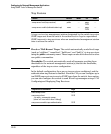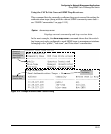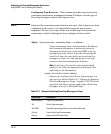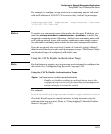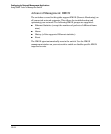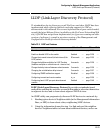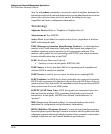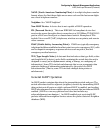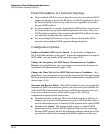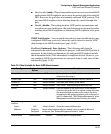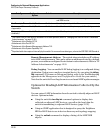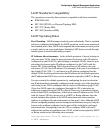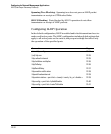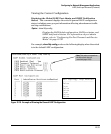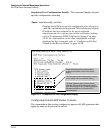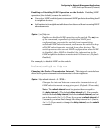
12-28
Configuring for Network Management Applications
LLDP (Link-Layer Discovery Protocol)
Packet Boundaries in a Network Topology
■ Where multiple LLDP devices are directly connected, an outbound LLDP
packet travels only to the next LLDP device. An LLDP-capable device does
not forward LLDP packets to any other devices, regardless of whether
they are LLDP-enabled.
■ An intervening hub or repeater forwards the LLDP packets it receives in
the same manner as any other multicast packets it receives. Thus, two
LLDP switches joined by a hub or repeater handle LLDP traffic in the same
way that they would if directly connected.
■ Any intervening 802.1D device or Layer-3 device that is either LLDP-
unaware or has disabled LLDP operation drops the packet.
Configuration Options
Enable or Disable LLDP on the Switch. In the default configuration,
LLDP is globally enabled on the switch. To prevent transmission or receipt of
LLDP traffic, you can disable LLDP operation (page 12-28)
Change the Frequency of LLDP Packet Transmission to Neighbor
Devices. On a global basis, you can increase or decrease the frequency of
outbound LLDP advertisements (page 12-28).
Change the Time-To-Live for LLDP Packets Sent to Neighbors. On a
global basis, you can increase or decrease the time that the information in an
LLDP packet outbound from the switch will be maintained in a neighbor LLDP
device (page 12-28).
Transmit and Receive Mode. With LLDP enabled, the switch periodically
transmits an LLDP advertisement (packet) out each active port enabled for
outbound LLDP transmissions, and receives LLDP advertisements on each
active port enabled to receive LLDP traffic (page 12-39). Per-Port
configuration options include four modes:
■ Transmit and Receive (tx_rx): This is the default setting on all ports. It
enables a given port to both transmit and receive LLDP packets, and to
store the data from received (inbound) LLDP packets in the switch’s MIB.
■ Transmit only (txonly): This setting enables a port to transmit LLDP
packets that can be read by LLDP neighbors. However, the port drops
inbound LLDP packets from LLDP neighbors without reading them. This
prevents the switch from learning about LLDP neighbors on that port.



